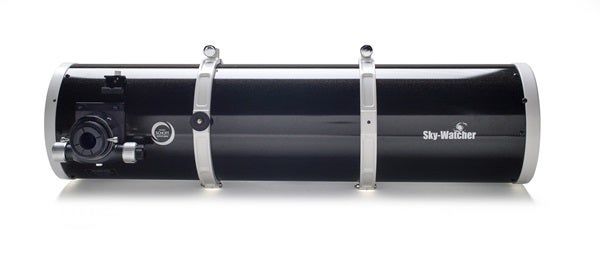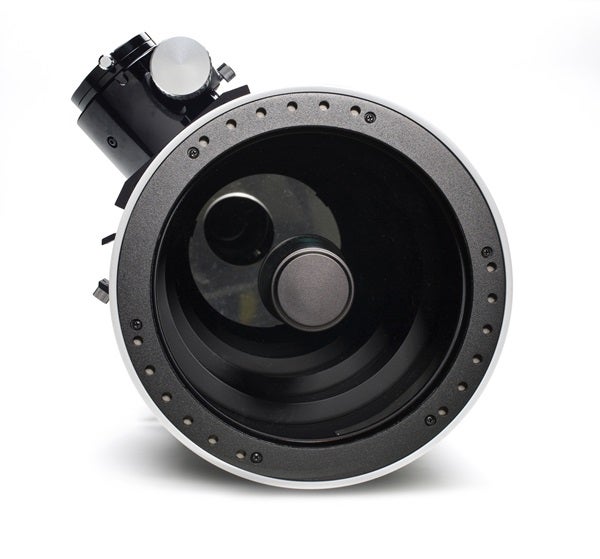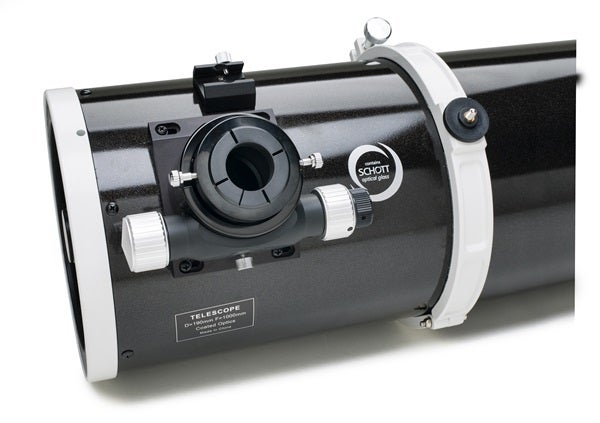Maksutovs come in two basic varieties: Maksutov-Cassegrains and Maksutov-Newtonians. Each uses a front corrector plate, or meniscus, and a rear-mounted primary mirror to collect light and bring it to a focus. Maksutov-Cassegrains, in which light passes through a central hole in the primary out to an eyepiece, have become popular among today’s amateurs thanks to improved mass-production methods (and thus lower costs).
But Maksutov-Newtonians, on which the eyepiece is at the tube’s front like a traditional Newtonian reflector, have always been custom-made telescopes carrying hefty price tags. The compound optical design eliminates two fundamental drawbacks of the mirror-only Newtonian reflector: astigmatism (where light rays focus at different points) and coma (where stars at the edge of the field of view have comet-like tails).
The Mak-Newt’s unattainability has started to erode over the past few years, with prices coming down and availability going up. To that end, Sky-Watcher USA offers its Maksutov-Newtonian 190mm, a 7½-inch f/5.3 Mak-Newt that proved to be an outstanding yet affordable example of the breed.
The beast within
At the heart of the 190mm is a spherical primary mirror teamed with a deeply curved front meniscus lens. Both are made of low-expansion borosilicate glass. Manufacturers prefer this type because it holds its precise curvature better as the temperature changes through the night.
Sky-Watcher USA uses an enhanced aluminizing for both the primary and secondary mirrors, resulting in 94 percent reflectivity. The meniscus lens is also fully multicoated with the company’s proprietary Metallic High Transmission Coatings to maximize image contrast. As I discovered, the results speak for themselves.
The primary mirrors in all Maksutov telescopes need to be larger than the stated aperture to work correctly. In this case, the primary is 8 inches (203 millimeters) across. The meniscus measures 7.48 inches (190mm), the determining aperture.
Because the secondary attaches directly to the front meniscus, there are no spider veins like in traditional Newtonians. Therefore, photographs taken through this scope will be free of diffraction spikes around bright stars.
Inside, the tube has five baffles to help maximize image contrast. Baffles prevent extraneous light from infiltrating the optical path. The tube’s interior is flat black, but to help improve image contrast even further, the manufacturer glued a small square of ultra-flat black material to the inside wall directly opposite the focuser.
Finish and extras
The optics sit in an attractive steel tube that sports metal-flake glossy black paint. The tube comes with white end rings as well as a backing plate that covers and seals the primary mirror’s cell.
The backing plate protects against dust infiltration, reducing the need to have the optics periodically recoated. A sealed optical system like this extends cool-down time, however, so take that into account when you’re setting up. You can attach a small fan to the rear plate to circulate air and accelerate acclimation. Sky-Watcher does not offer a fan at present, but other dealers (like Orion Telescopes) do.
Standard accessories that come with the 190mm include a dual-speed 2″ focuser, a 9×50 correct-image right-angle finder scope and mount, white rotating tube rings, and a Vixen-style dovetail plate for attaching the scope to many mounts.
Unlike some early dual-speed focusers packaged with imported scopes, the 190mm’s unit is well made. Focusing was sharp and precise. The included 1¼” adapter is an unusual “sliced” design that claims to keep eyepieces centered more precisely. It worked fine for me.
The focuser is low profile for photographic use, but also includes a built-in extension tube that extends 2.13 inches (54mm) for eyepieces that require more back-focus. That’s a nice touch that I grew to appreciate during viewing.
The 190mm’s optical tube assembly (OTA) measures 37.5 inches (952mm) long and weighs 27.4 pounds (12.4kg). That put it at the upper limit of the German equatorial mount I used for this evaluation. And that points to one of the few drawbacks of Mak-Newts: They are heavy. Because most amateurs usually purchase only the OTA, make sure your mount is sturdy enough for the task, especially if you are planning to use it for astrophotography. Sky-Watcher USA’s own EQ-6 mount is a good match.
The tube’s weight makes rotating it in the rings a challenge. I had to loosen them fully to move it. The tube is also front heavy because of the lens, so you’ll have to move it back from the center position between the rings to achieve balance.
Under the stars
After setting up the scope in my suburban yard and allowing time for it to acclimate to the ambient temperature, I swung it toward Saturn, which was in Scorpius. Despite the planet’s low altitude, the image was sharp and clear. The rule of thumb states not to exceed a magnification of 50x per inch of aperture. I easily surpassed that on this steady summer night. Saturn remained sharp even as I approached 500x with a top-end 5mm eyepiece and 2.5x Barlow lens.
Precise focusing with the two-speed Crayford focuser was easy, even at a high power like the one I used on Saturn. And you can lock the focuser in place to prevent slippage. I found the lock sufficiently strong to hold my DSLR in place. While some owners may be tempted to upgrade to an aftermarket focuser, I’d recommend you give the stock unit a good test first. You just may be pleasantly surprised.
Nearby, globular cluster M4 awaited. Stellar resolution was easy at 150x, and I spotted the cluster’s unique “bar” of stars across its core. Other summer globulars in Ophiuchus, Sagittarius, and, of course, the Hercules Cluster (M13) also clearly resolved into myriad stars.
Summer nights where I live can be damp. And that brings up a second, minor drawback to Mak-Newts (as well as all refractors and catadioptric instruments). The front meniscus can turn into a moisture magnet once the temperature reaches the dew point. Sky-Watcher does not sell a simple dew shield for the scope. Fortunately, many vendors do. A flexible dew shield is the minimum you’ll need. A powered dew heater system is even better.
Bottom line
Issues like dewing and weight can be dealt with. Those minor hindrances aside, I came away impressed with the Sky-Watcher USA’s 190mm scope. It is an exceptionally versatile instrument. The images were among the best I have ever seen through any comparably sized scope, regardless of design or price. The 190mm is just as adept at visual deep-sky observing as it is for guided astrophotography. But make no mistake, it provides stunning planetary views, too. After spending many enjoyable hours with the 190mm, I can now appreciate why a growing number of amateurs feel that Maksutov-Newtonians are the finest telescopes of all.













